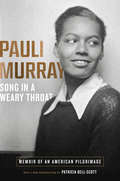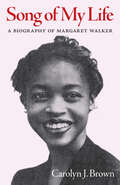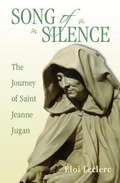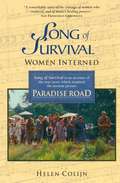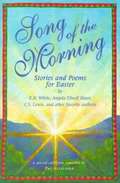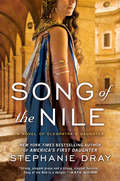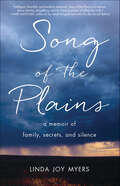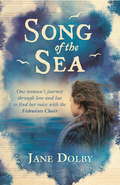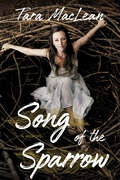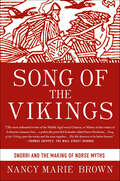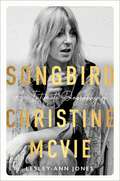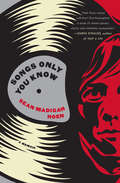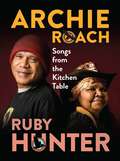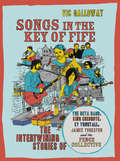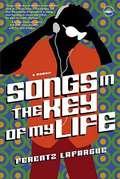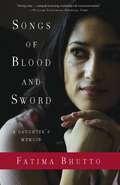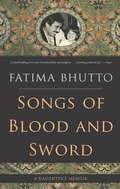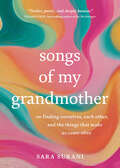- Table View
- List View
Song in a Weary Throat: Memoir Of An American Pilgrimage
by Patricia Bell-Scott Pauli MurrayA prophetic memoir by the activist who “articulated the intellectual foundations” (The New Yorker) of the civil rights and women’s rights movements. <P><P> First published posthumously in 1987, Pauli Murray’s Song in a Weary Throat was critically lauded, winning the Robert F. Kennedy Book Award and the Lillian Smith Book Award among other distinctions. Yet Murray’s name and extraordinary influence receded from view in the intervening years; now they are once again entering the public discourse. At last, with the republication of this “beautifully crafted” memoir, Song in a Weary Throat takes its rightful place among the great civil rights autobiographies of the twentieth century. In a voice that is energetic, wry, and direct, Murray tells of a childhood dramatically altered by the sudden loss of her spirited, hard-working parents. Orphaned at age four, she was sent from Baltimore to segregated Durham, North Carolina, to live with her unflappable Aunt Pauline, who, while strict, was liberal-minded in accepting the tomboy Pauli as “my little boy-girl.” In fact, throughout her life, Murray would struggle with feelings of sexual “in-betweenness”—she tried unsuccessfully to get her doctors to give her testosterone—that today we would recognize as a transgendered identity. <P><P> We then follow Murray north at the age of seventeen to New York City’s Hunter College, to her embrace of Gandhi’s Satyagraha—nonviolent resistance—and south again, where she experienced Jim Crow firsthand. An early Freedom Rider, she was arrested in 1940, fifteen years before Rosa Parks’ disobedience, for sitting in the whites-only section of a Virginia bus. Murray’s activism led to relationships with Thurgood Marshall and Eleanor Roosevelt—who respectfully referred to Murray as a “firebrand”—and propelled her to a Howard University law degree and a lifelong fight against "Jane Crow" sexism. We also read Betty Friedan’s enthusiastic response to Murray’s call for an NAACP for Women—the origins of NOW. Murray sets these thrilling high-water marks against the backdrop of uncertain finances, chronic fatigue, and tragic losses both private and public, as Patricia Bell-Scott’s engaging introduction brings to life. <P><P> Now, more than thirty years after her death in 1985, Murray—poet, memoirist, lawyer, activist, and Episcopal priest—gains long-deserved recognition through a rediscovered memoir that serves as a “powerful witness” (Brittney Cooper) to a pivotal era in the American twentieth century.
Song of Deborah
by Bette M. RossThis is a fictionalized story of the prophetess, Deborah which draws upon material found in the Old Testament book, Judges. The beautiful Deborah, caught between the love of Lapidoth, the Philistine caravan master, and Sisera, King of Canaan, follows the call of Yahweh to become God's oracle and Israel's first woman judge.
Song of My Life: A Biography of Margaret Walker
by Carolyn J. BrownMargaret Walker (1915–1998) has been described as “the most famous person nobody knows.” This is a shocking oversight of an award-winning poet, novelist, essayist, educator, and activist as well as friend and mentor to many prominent African American writers. Song of My Life reintroduces Margaret Walker to readers by telling her story, one that many can relate to as she overcame certain obstacles related to race, gender, and poverty. Walker was born in 1915 in Birmingham, Alabama, to two parents who prized education above all else. Obtaining that education was not easy for either her parents or herself, but Walker went on to earn both her master's and doctorate degrees from the University of Iowa. Walker's journey to become a nationally known writer and educator is an incredible story of hard work and perseverance. Her years as a public figure connected her to Richard Wright, Langston Hughes, Alex Haley, and a host of other important literary and historical figures. This biography opens with her family and those who inspired her—her parents, her grandmother, her most important teachers and mentors—all significant influences on her reading and writing life. Chapters trace her path over the course of the twentieth century as she travels to Chicago and becomes a member of the South Side Writers' Group with Richard Wright. Then she is accepted into the newly created Master of Fine Arts Program at the University of Iowa. Back in the South, she pursued and achieved her dream of becoming a writer and college educator as well as wife and mother. Walker struggled to support herself, her sister, and later her husband and children, but she overcame financial hardships, prejudice, and gender bias and achieved great success. She penned the acclaimed novel Jubilee, received numerous lifetime achievement awards, and was a beloved faculty member for three decades at Jackson State University in Jackson, Mississippi.
Song of Silence
by Éloi LeclercSaint Jeanne Jugan, foundress of the Little Sisters of the Poor, was not recognized as such until after her death. Jeanne lived through repeated betrayals and transformed these trials into a path toward holiness that helped her connect with the suffering of Christ. Read the fascinating spiritual journey of this remarkable saint.
Song of Survival
by Helen ColijnSurvivor Helen Colijn's account of her war time experiences is a window into a largely over looked dimension of World War II-the imprisonment of women and children in Southeast Asia by the Japanese and how these prisoners of war responded to their dire circumstances. Held in captivity for nearly four years, more than a third of the women in Helen's camp died of disease or starvation.Yet their courage, faith, resiliency, ingenuity, and camaraderie provide us with enduring lessons on living. Though they had no musical instruments, the women had their voices, and from memory scored classical works for symphony and piano. The music that helped sustain them while in captivity is a lasting and precious gift of these women to a world that has witnessed far too much war.Song of Survival inspired the motion picture Paradise Road, starring Glenn Close and a soundtrack of the movie Paradise Road Soundtrack
Song of Survival
by Helen ColijnSurvivor Helen Colijn's account of her war time experiences is a window into a largely over looked dimension of World War II-the imprisonment of women and children in Southeast Asia by the Japanese and how these prisoners of war responded to their dire circumstances. Held in captivity for nearly four years, more than a third of the women in Helen's camp died of disease or starvation.Yet their courage, faith, resiliency, ingenuity, and camaraderie provide us with enduring lessons on living. Though they had no musical instruments, the women had their voices, and from memory scored classical works for symphony and piano. The music that helped sustain them while in captivity is a lasting and precious gift of these women to a world that has witnessed far too much war.Song of Survival inspired the motion picture Paradise Road, starring Glenn Close and a soundtrack of the movie Paradise Road Soundtrack
Song of Survival
by Helen ColijnSurvivor Helen Colijn's account of her war time experiences is a window into a largely over looked dimension of World War II-the imprisonment of women and children in Southeast Asia by the Japanese and how these prisoners of war responded to their dire circumstances. Held in captivity for nearly four years, more than a third of the women in Helen's camp died of disease or starvation.Yet their courage, faith, resiliency, ingenuity, and camaraderie provide us with enduring lessons on living. Though they had no musical instruments, the women had their voices, and from memory scored classical works for symphony and piano. The music that helped sustain them while in captivity is a lasting and precious gift of these women to a world that has witnessed far too much war.Song of Survival inspired the motion picture Paradise Road, starring Glenn Close and a soundtrack of the movie Paradise Road Soundtrack
Song of the Morning: Easter Stories and Poems for Children
by Pat AlexanderHere is a book for the whole family to enjoy this Easter, the year round, and for years to come. The Easter events form the climax to a story that began long before. So this book starts with the creation and spoiling of the world, God's rescue plan and the coming of Jesus. The Bible's stories of Palm Sunday, Good Friday and Easter Day are placed in context.
Song of the Nile (Cleopatra's Daughter Trilogy #2)
by Stephanie DraySorceress. Seductress. Schemer. Cleopatra's daughter is the one woman with the power to destroy an empire... Having survived her perilous childhood as a royal captive of Rome, Selene pledged her loyalty to Augustus and swore she would become his very own Cleopatra. Now the young queen faces an uncertain destiny in a foreign land.The magic of Isis flowing through her veins is what makes her indispensable to the emperor. Against a backdrop of imperial politics and religious persecution, Cleopatra's daughter beguiles her way to the very precipice of power. She has never forgotten her birthright, but will the price of her mother's throne be more than she's willing to pay?
Song of the Plains: A Memoir of Family, Secrets, and Silence
by Linda Joy MyersEver since she was a child, Linda Joy Myers felt the power of the past. As the third daughter in her family to be abandoned or estranged by a mother, she observed the consequences of that heritage on the women she loved as well as herself. But thanks to the stories told to her by her great-grandmother, Myers received a gift that proved crucial in her life: the idea that everyone is a walking storybook, and that we all have within us the key to a deeper understanding of life—the secret stories that make themselves known even without words. Song of the Plains is a weaving of family history that starts in the Oklahoma plains and spans over forty years as Myers combs through dusty archives, family stories, and genealogy online. She discovers the secrets that help to explain the fractures in her family, and the ways in which her mother and grandmother found a way not only to survive the great challenges of their eras, but to thrive despite mental illness and abuse. She discovers how decisions made long ago broke her family apart—and she makes it her life's work to change her family story from one of abuse and loss to one of finding and creating a new story of hope, forgiveness, healing, and love.
Song of the Road
by Cyrus StearnsIn Song of the Road, Tsarchen Losal Gyatso (1502-66), a tantric master of the Sakya tradition of Tibetan Buddhism, weaves ecstatic poetry, song, and accounts of visionary experiences into a record of pilgrimage to central Tibet. Translated for the first time here, Tsarchen's work, a favorite of the Fifth Dalai Lama, brims with striking descriptions of encounters with the divine as well as lyrical portraits of Tibetan landscape. The literary flights of Song of the Road are anchored by Tsarchen's candid observations on the social and political climate of his day, including a rare example in Tibetan literature of open critique of religious power. Like the Japanese master Basho's famous Narrow Road to the Interior, written 150 years later, Tsarchen's travelogue contains a mixture of luminous prose and verse, rich with allusions. Traveling on horseback with a band of companions, Tsarchen visited some of the most renowned holy sites of the Tsang region, incluing Jonang, Tropu, Ngor, Shalu, and Gyantse. In his introduction and copious notes, Cyrus Stearns unearths the layers of meaning concealed in the text, excavating the history, legends, and lore associated with people and places encountered on the pilgrimage, revealing the spiritual as well as geographical topography of Tsarchen's journey.
Song of the Sea
by Jane DolbyJane Dolby fell in love with a fisherman - the most dangerous peacetime occupation that exists - leading her to find a place in a traditional British world that many have forgotten. Jane was not expecting to fall in love, but she did with Colin, a local fisherman in her hometown. Then one day she faces the loss every fisherman's wife fears: the disappearance of her husband when his boat overturns at sea. Three days later, the boat is finally dredged up, without Colin. As the same time as Jane struggles with her grief, she must fight to keep a roof over her family's heads. With the help and kindness of friends and strangers, the fishing world rallies around one of their own and in time, Jane forms a plan to give something back to the community that has helped her. Jane brings together 40 women from fishing communities up and down the country to release a charity single, founding The Fishwives Choir, and gives a voice to women previously unheard. SONG OF THE SEA is the true story of one woman's love and loss, and after years in which grief stole her ability to sing, she finds her own voice again.
Song of the Sea
by Jane DolbyJane Dolby fell in love with a fisherman - the most dangerous peacetime occupation that exists - leading her to find a place in a traditional British world that many have forgotten. Jane was not expecting to fall in love, but she did with Colin, a local fisherman in her hometown. Then one day she faces the loss every fisherman's wife fears: the disappearance of her husband when his boat overturns at sea. Three days later, the boat is finally dredged up, without Colin. At the same time as Jane struggles with her grief, she must fight to keep a roof over her family's heads. With the help and kindness of friends and strangers, the fishing world rallies around one of their own and in time, Jane forms a plan to give something back to the community that has helped her. Jane brings together 40 women from fishing communities up and down the country to release a charity single, founding The Fishwives Choir, and gives a voice to women previously unheard.SONG OF THE SEA is the true story of one woman's love and loss, and after years in which grief stole her ability to sing, she finds her own voice again.
Song of the Sparrow: A Memoir
by Tara MacLeanAn astonishing memoir about how song saved a lifeSinger/songwriter Tara MacLean has had an extraordinary musical career. From being discovered singing on a BC ferry to touring with Dido, Tom Cochrane and Lilith Fair, her solo albums and those with the band Shaye have touched legions of fans. But she hasn’t, until now, disclosed the details of how the power of song saved her from a childhood filled with danger.From her earliest days in the backwoods of Prince Edward Island, Tara was surrounded by nature, the songs of her musician father and the love of her actor mother. But love was not enough to feed their growing family, nor were the Wiccan, then evangelical Christian teachings her parents followed. Hunger and uncertainty were constant companions, as were the dangers that began to enter her world. Predators can come in many forms from even the most trusted circles, and Tara soon learned that a young girl is never safe. It was only through Tara’s inner strength and the solace she found in singing that she created a refuge and a future for herself. Song of the Sparrow is a daring, heartbreaking and provocative memoir of a life filled with music, told with the same raw, open and elegant poetry that Tara’s fans have come to expect. From Tara’s childhood in PEI through her teenage years in BC to her meteoric rise in music, Song of the Sparrow reveals her remarkable strength and shows that a song and a wide-open heart are the best weapons for fighting monsters. Don’t miss Tara’s new album, Sparrow, which is being released concurrently with this memoir.
Song of the Vikings: Snorri and the Making of Norse Myths
by Nancy Marie Brown“A wonderfully evocative biography of the . . . 13th century Icelandic writer and chieftain” who wrote the immortal stories of Thor, Odin, Valhalla, and Ragnarök (Guardian, UK).Much like Greek and Roman mythology, Norse myths are still with us. Famous storytellers from JRR Tolkien to Neil Gaiman have drawn their inspiration from the long-haired, mead-drinking, marauding and pillaging Vikings. But few of us know much about the creator of these immortal heroes: a thirteenth-century Icelandic chieftain by the name of Snorri Sturluson.Like Homer, Snorri was a bard, writing down and embellishing the folklore and pagan legends of medieval Scandinavia. Unlike Homer, Snorri was a man of the world—a wily political power player, one of the richest men in Iceland who came close to ruling it, and even closer to betraying it. In Song of the Vikings, award-winning author Nancy Marie Brown brings Snorri Sturluson’s story to life in a richly textured narrative that draws on newly available sources.
Songbird: An Intimate Biography of Christine McVie
by Lesley-Ann JonesIn this revealing portrait of keyboardist, lyricist, and vocalist Christine Mcvie of Fleetwood Mac, readers will get an exclusive glimpse of the band's "mother figure". Christine McVie–born Christine Perfect–was the quintessentially English rock star, as both the backbone and the beating heart of Fleetwood Mac. She wrote and performed many of their greatest hits, and was dubbed 'the mother' of the band. It was Christine who contained the flock, regrouped them when they went AWOL, and always got them back on track. And yet, as the "engine" of the band during their Rumours era–an album which charted the romantic disintegration within the band–Christine's personal life was every bit as tempestuous as those of her bandmates. Told by an author who herself was friends with Christine, and with new contributions from those who knew her best, Songbird offers a true insider's view and psychological insight into Christine as a both a woman and a musician––the ultimate picture of a rock legend and a national treasure.
Songs Only You Know: A Memoir
by Sean Madigan HoenSongs Only You Know begins when Sean is 18 and spans a dark decade when his father succumbs to crack addiction, his parents' marriage crumbles, and his younger sister spirals into a fatal depression. Sean's salvation is music. His refuge is the stage. Slumming in the trenches as a low-rent musician coincides with the worst years of his family's life, yet his wayward rock band mates serve as a surrogate family and, in a way, the gravity and darkness of his personal life folds into the humor and misadventure found in a parallel world that exposes his "secret life" as a musician. Ultimately, however, by coming so near to the fates of his lost kin, Sean is forced to confront what has happened, as well as himself.Fierce. Vivid. Brave. Songs Only You Know cuts to the bone. Sean and his family's all-too-human frailties resonate long after the book is finished. Despite devastating odds, their story inspires and offers promise of transformation.
Songs from the Black Chair: A Memoir of Mental Interiors
by Charles BarberDay after day, night after night, the desperate men come and sit in the black chair next to Charles Barber's desk in a basement office at Bellevue and tell of their travails, of prison and aids and heroin, of crack and methadone and sexual abuse, and the voices that plague them. In the silence between the stories, amid the peeling paint, musty odor, and flickering fluorescent light, Barber observes that this isn't really where he is supposed to be. How this child of privilege, product of Andover and Harvard and Columbia, came to find himself at home among the homeless of New York City is just one story Barber tells in Songs from the Black Chair. Interlaced with his memoir, and illuminating the nightmare of mental illness that gripped him after his friend's suicide, are the stories of his confidants at Bellevue and the "mental health" shelters of Manhattan-men so traumatized by the distortions of their lives and minds that only in the chaotic aftermath of 9/11 do they feel in sync with their world. In the intertwined narrative of these troubled lives and his own, Charles Barber brings to shimmering light some of the most disturbing and enduring truths of human nature. Charles Barber is an associate of the Yale Program for Recovery and Community Health, Yale University School of Medicine.
Songs from the Kitchen Table: Lyrics and Stories
by Archie Roach Ruby HunterThe ultimate illustrated commemoration of iconic Australian musicians Archie Roach and Ruby Hunter in songs, stories, photographs and tributes. Since he left us, Archie Roach&’s legacy has continued to soar, like his totem animal from his mother&’s ancestral lands, the wedge-tailed eagle. Archie&’s songs stand as anthems for both the experience of dispossession and our shared humanity.Songs from the Kitchen Table is a tribute to the power of Archie&’s voice, and to the love of music he shared with his life partner and musical collaborator, Ruby Hunter. This beautiful, illustrated volume contains the lyrics to over one hundred of their songs, carefully curated by Archie&’s manager and friend, Jill Shelton. From Archie&’s breathtaking early works, &‘Took the Children Away&’ and &‘Charcoal Lane&’, to the timeless classics &‘Tell Me Why&’, Ruby&’s &‘Down City Streets&’, and Archie&’s final masterpiece, &‘One Song&’, the lyrics are accompanied by stories about their composition, rare photographs, original artwork, and heartfelt tributes to Archie and Ruby from those who knew and loved them. With forewords by their long-time friends and musical collaborators, Emma Donovan, Paul Kelly and Jack Latimore, Songs from the Kitchen Table is a celebration of one of Australia&’s great creative partnerships, and a testament to the ongoing power of plain-spoken truths.
Songs in the Key of Fife: The Intertwining Stories of the Beta Band, King Creosote, KT Tunstall, James Yorkston and the Fence Collective
by Vic GallowayA look at the careers of several acclaimed Scottish musicians from Fife, from their early days to the highs and lows of the music industry, to today. The East Neuk of Fife, Scotland, may seem like an unusual place for a musical revolution, but as this firsthand account reveals, there is more to the sleepy fishing villages and rolling fields, and a small community of musicians has crept up on the world. From psychedelic troubadours the Beta Band to the Billboard chart star KT Tunstall, acclaimed singer-songwriter James Yorkston, and the reigning monarch and lynchpin of the Fence Collective, King Creosote, this book plots the unique, intertwining tales of these Fifers from their schooldays to the present day. This story, full of personal anecdotes and exclusive interviews, provides an in-depth look at a unique collective of musicians who have experienced the extreme highs and the desperate lows of the music business and how a craggy outpost on the east coast of Scotland had a role in crafting talented artists.Praise for Songs in the Key of Fife&“DJ turned author Galloway does a superb job of documenting the lives of these artists, misfits and &“heads,&” not least because he is a Fife lad himself.&” —Mojo (UK)&“A remarkable insight into the pitfalls of the music industry . . . essential reading for any young musician in Scotland thinking about trying to make a go of it—not least for the rude awakening it may offer before their dreams are shattered. But it also shows how success can be achieved against seemingly insurmountable odds.&” —The Scotsman (UK)
Songs in the Key of My Life: A Memoir
by Ferentz Lafargue"Music is a world within itself, with a language we all understand. " --Stevie Wonder, "Sir Duke." In 2003, young professor Ferentz LaFargue traveled to Paris, where his fiancée, Tricia, declared she wasn't happy with their relationship, ending what he thought was a wonderful engagement. After days of "craying"--"that sorrow-laden blend of crying and praying delivered in perfect pitch by those in mourning"--Ferentz happened upon Stevie Wonder's 1976 classic double album Songs in the Key of Life. Listening to it anew was a healing, spiritual trip down memory lane, helping him to come to terms with his breakup and reflect on how songs in general have been linked to his life. In this book, Ferentz invites us to get cozy and listen as he hits PLAY on meaningful tracks from Wonder and others, including Lauryn Hill, Wyclef Jean, LL Cool J, Beenie Man, Sheryl Crow, Roberta Flack, Donny Hathaway, and Black Sabbath. He recalls: How the fusion of rock and rap in the breakthrough Run-D. M. C. /Aerosmith video "Walk This Way" helped to change an adolescent Ferentz from outcast to authority figure How Michael Jackson'sThriller brought back a traumatic childhood experience How Kanye West's "Jesus Walks" speaks to the tension between his Christian beliefs and his need to rip it up in clubs as a hip-hop head In the tradition of Nick Hornby's Songbook¸ these words paint a portrait of a life framed by sounds, allowing all of us to think about what songs have been key in our own lives.
Songs of Blood and Sword
by Fatima BhuttoIn September 1996, fourteen-year-old Fatima Bhutto hid in a windowless dressing room, shielding her baby brother, while shots rang out in the dark outside the family home in Karachi. This was the night her father Murtaza was murdered. It was the latest in a long line of tragedies for one of the world's best-known political dynasties.Songs of Blood and Sword tells the story of a family of feudal landlords who became powerbrokers. It is an epic tale of intrigue, the making of modern Pakistan, and ultimately, tragedy. A searing testament to a troubled land, Songs of Blood and Sword reveals a daughter's love for her father and her search to uncover the truth of his life and death.
Songs of Blood and Sword: A Daughter's Memoir
by Fatima BhuttoIn September 1996, fourteen-year-old Fatima Bhutto hid in a windowless dressing room, shielding her baby brother, while shots rang out in the dark outside the family home in Karachi. This was the night her father Murtaza was murdered. It was the latest in a long line of tragedies for one of the world's best-known political dynasties. Songs of Blood and Sword tells the story of a family of feudal landlords who became power brokers. It is an epic tale of intrigue, the making of modern Pakistan, and ultimately, tragedy. A searing testament to a troubled land, Songs of Blood and Sword reveals a daughter's love for her father and her search to uncover the truth of his life and death.
Songs of Blood and Sword: A Daughter's Memoir
by Fatima BhuttoIn September 1996, fourteen-year-old Fatima Bhutto hid in a windowless dressing room, shielding her baby brother, while shots rang out in the dark outside the family home in Karachi. This was the night her father Murtaza was murdered. It was the latest in a long line of tragedies for one of the world’s best-known political dynasties. Songs of Blood and Swordtells the story of a family of feudal landlords who became powerbrokers. It is an epic tale of intrigue, the making of modern Pakistan, and ultimately, tragedy. A searing testament to a troubled land,Songs of Blood and Swordreveals a daughter’s love for her father and her search to uncover the truth of his life and death.
Songs of My Grandmother: On Finding Ourselves, Each Other and the Things That Make Us Come Alive
by Sara SuraniA collection of poetry and prose that offers comfort, community, and belonging through stories of love, loss, change, and rebirth.In this collection of poetry and prose, Sara Surani weaves together the universal songs of her ancestors, voices of women she has met across the world, and her own reflections. These are not songs with music, but melodies of memory and spirit–of love and laughter. Of curiosity and wonder. Of healing and hope. Of the little moments when time slows down.The daughter of Pakistani-Muslim immigrants who moved to South Texas to give their daughter a better life, Surani draws on her roots to create a tapestry of stories; comforting and deeply familiar. Throughout the book, she braids shared struggles with collective joy, reminding us of all that we hold in common while conjuring a deep sense of belonging–one that is needed now, more than ever.
